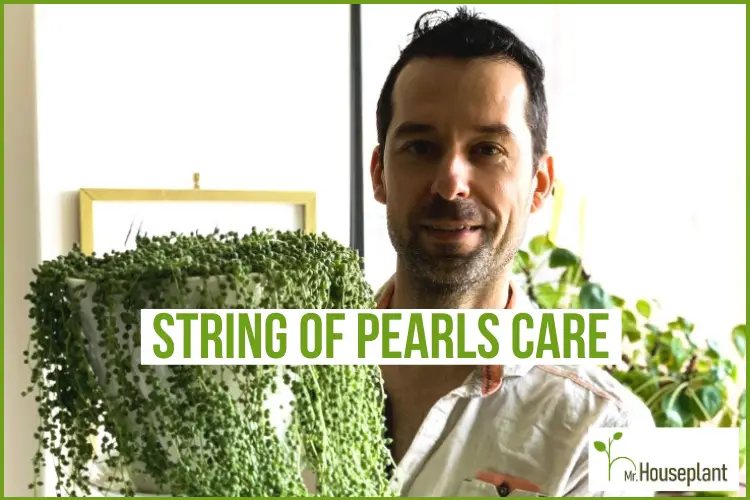
Is your String of Pearls plant dying? Read on to find out all the possible reasons for that and how to prevent it with proper watering, temperature, humidity, soil, repotting, and other factors that can affect your plant’s life.
| Botanical Name (Latin Name/Scientific Name): | Senecio rowleyanus |
| Common name: | String of Pearls |
| Light: | medium light (1,000 lux – 2,500+ lux) |
| Watering: | when the soil is completely dry |
| Soil: | well-draining mix |
| Repotting: | once a year |
| Temperature: | 70°F to 80°F (21°C to 26°C) |
| Humidity: | adapts well to any humidity |
| Toxicity for Pets: | Yes (vomiting, lethargy, abdominal upset) |
| Toxicity for Humans: | Yes (liver, brain, kidneys, heart, liver damage) |
| Propagation: |
|
| Pruning: | Prune dead or diseased growth or when you want the plant to branch out |
Light Requirements
| Minimal amount of light: | 1,000 lux (100 FC) |
| Optimal amount of light: | 2,500+ lux (250+ FC) |
| Direct sun tolerance: | 1-2 hours |
| Category: | medium light |
Light is ABSOLUTELY the most important requirement that needs to be fulfilled in order to keep these plants alive. String of Pearls plants need bright indirect light, which means you should keep them right next to the window, not 5 feet away from the window. Light intensity drops significantly with each foot away from the window.
Lack of light is one of the most common reasons why these plants die. So don’t be afraid to even expose them to direct, very early morning sun, which is not too strong and won’t burn the plant’s leaves. Even 2 to 3 hours of the direct sunlight will make a big difference. And don’t worry, your String of Pearls will not only handle this amount of light well but welcome it.
Light intensity of direct sun is many times stronger than indirect light. This is why a few hours of early morning sun can make a huge difference. Indirect light can go to about 20,000 lux (2,000 FC), but most of the time in our homes it’s less than 5,000 lux, even below 1,000 lux (100FC). But direct sunlight gives 40,000 to over 100,000 lux of light (4,000-10,000 FC). Notice how much more that is. So even 2 to 3 hours of direct sunlight make a big difference.
When it comes to light after 10am, that can be tricky though. As direct sunlight gets stronger during the day, the possibility of sunburns increases. But your plant will enjoy early morning direct light.
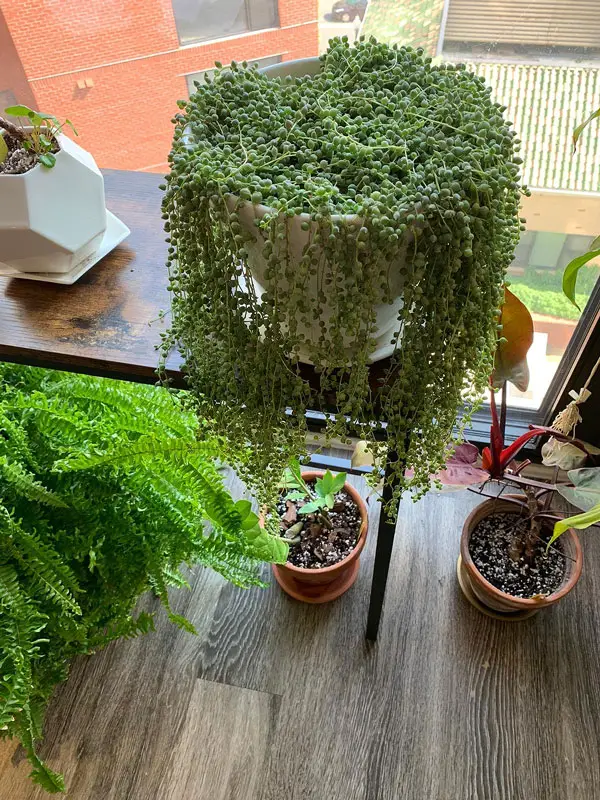
My string of pearls plant
Good light will even reduce or alleviate the impact of overwatering. As your String of Pearls plant gets more light, it will photosynthesize more, and the roots will pull more water from the soil, helping it dry out faster.
Water Needs
Overwatering is the most common reason why these plants rot and die.
Water your String of pearls only when the soil is completely dry. Use a chopstick to check the soil dryness. Stick the chopstick all the way down, and if it comes out fully dry with no soil attached, you’ll know that it’s time to water.
You can also lift the pot to check the weight. A pot with wet soil is much heavier than a pot with dry soil. It will take you some time to learn how much a watered vs. dry pot weighs, but here is how you can do it easily.
When watering time comes (and you know it’s watering time because you checked with a chopstick) and the soil is fully dry to the bottom, lift the pot and feel its weight. Then water thoroughly and feel the weight again. It’s much heavier, right? Keep lifting every two days, until you feel it’s fully dry. If needed, use a chopstick as support. But after a couple of waterings like this, you will become an expert in figuring out if it’s watering time just by quickly lifting the pot.
You can also wait for the pearls to get soft to the touch — just press a leaf (pearl) between your fingers to feel this. The leaves will even shrivel and get a bit wrinkly when they get in real need of water. It is better to wait for this moment and water them then than to water them too frequently. Next time just water them a day or two before they become wrinkly, as consistently waiting for them to get wrinkly is stressful for the plant.
Humidity Needs
These houseplants don’t care about humidity, just be sure not to overwater the plant.
Temperature Requirements
You can put your String of Pearls outside, but only during the spring and summer months. String of Pearls is a true desert plant and likes warm and dry climate, just like in its homeland South Africa. The temperature at which to grow a String of pearls should be above 50° F, ideally, between 70-80°F. Don’t expose them to frost or freezing temperatures.
Keeping the plant outside will provide it with much more light than it can ever get indoors. This will speed up its growth, but as the soil will be drying out much faster, you will probably need to increase your watering frequency.
Fertilizing
If you’ve found the right balance in watering and you’re managing to provide your plant with enough light, your String of Pearls is probably healthy and happy. In that case, you may find that you don’t need to fertilize it at all.
However, if your plant is putting out new growth, you can fertilize it if you like. Use a succulent or cacti diluted liquid fertilizer up to once per month.
Soil
Keep in mind that the String of Pearls is a succulent plant. Therefore, when potting or repotting your String of pearls, make sure to use a soil mix that drains well. The one I highly recommend is here.
In case you wish to make your own potting soil mix, go ahead, just make sure to create a mix that will drain easily, that is not too rich, and that you’ll be able to fertilize later as needed.
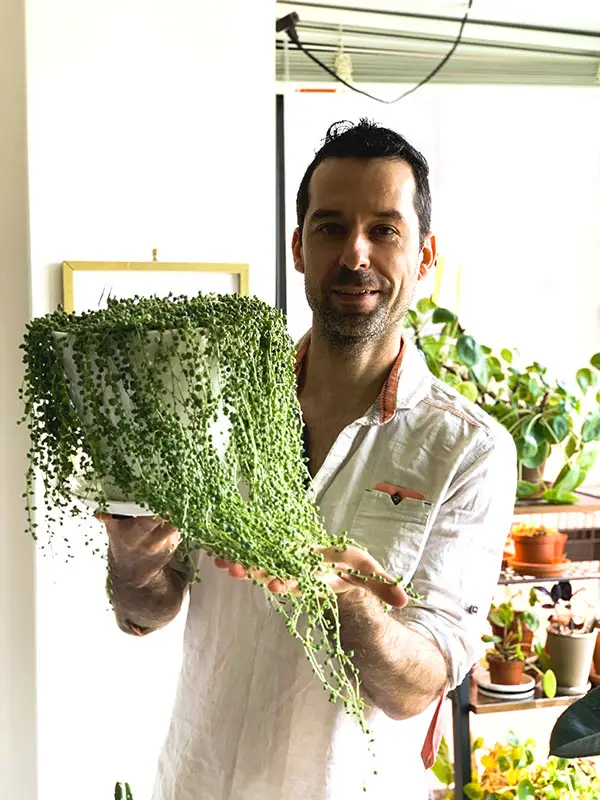
Mr. Houseplant and String of Pearls
For example, I used Proven Winners all-purpose garden potting soil as a base for my own mix. I mixed it with perlite (1 part perlite, 1 part Proven Winners proportion). Adding perlite is very important if you’re going to keep your plant in a plastic or ceramic pot. These materials don’t let the soil dry out as fast as succulents need it and as terracotta pots would let it. Perlite helps accelerate the drying of the soil which makes your String of Pearls happy.
Repotting
String of Pearls plants have a small root system, so you don’t need to worry about repotting them into large pots. In fact, if you move your plant into a pot that is much larger than the previous one, you risk it rotting. Due to the large amount of soil it contains, it will stay wet for a long time.
When repotting your String of Pearls, I recommend using, as an ideal solution, a terracotta pot and making sure that any pot you may be using has a drainage hole.
Here’s how I repotted my String of Pearls.
- I got a pot that is 1” to maximum 2” bigger than the current
- I filled up the new pot up to 1/3 of the height with the previously mentioned potting mix and pressed it a bit.
- Then I took the plant out of the old plastic pot and loosened the root ball. This is the crucial step.
- I did not replace all of the old soil as there was no need — it was a newly purchased plant and old soil wasn’t compacted.
- After placing the String of Pearls in the new pot, I filled up the new pot with soil.
- I like to press the new soil firmly. Now, I did not press extremely hard, but even if I did, I would never be able to compress the soil as much as it will compress on its own after a year or two.
I recommend repotting String of Pearls plant annually to ensure the soil doesn’t get compacted or lacks oxygen. If you notice roots coming out of the drainage holes, you can be sure that it’s definitely time to repot.
Toxicity To Humans
String of Pearls is toxic to humans according to California Poison Control System (CPCS). This plant, if ingested, can cause heart, liver, kidney, or brain damage.
Toxicity To Pets
String of Pearls is toxic to pets according to the American Society For The Prevention Of Cruelty To Animals (ASPCA). If ingested, it can cause abdominal upset (vomiting) and lethargy.
Pruning
Pruning String of Pearls will stimulate branching. To prune your String of Pearls, you will need a pair of sharp, sterilized scissors or pruning shears. Prune half an inch below the end of a stem, to promote branching. You will also want to remove dead stems and pearls. To remove dead pearls (brown or dry), you can gently pull them off with your fingers.
Propagation
There are a couple of ways to propagate a String of pearls. Here’s how I used water when propagating String of Pearls:
- Cut off one of the strings
- Remove the bottom few pearls. Roots will grow from the nodes where each of the pearls was.
- Put in water. Propagating String of Pearls plant is a VERY quick process; you’ll be surprised when you get roots in only a few days.
You can also see the demonstration in the video below.
The same rules apply to any propagation:
- Take only healthy cuttings.
- Provide bright indirect sunlight, aim for light over 5,000 lux. More light speeds up propagation and increases the success rate.
- Replace water weekly.
- Using a heat mat or an air pump will help increase propagation speed and chances of success. Root needs oxygen and an air pump provides a constant inflow of oxygen, whereas a heat mat increases the temperature of water by several degrees, which also speeds up rooting.lace water weekly.
- Once the roots are 1 to 2 inches long, pot in soil.
- When in soil, water your String of Pearls in the same way as the main plant, once the soil gets fully dry. Pearls will become soft to the touch and wrinkly when they need water.
- Don’t forget to have fun! :)
Pests
Common pests that can infest String of Pearls are mealybugs, aphids and fungus gnats. There are several ways to get rid of mealybugs and aphids: horticultural or neem oil, insecticidal soap, or systemic insecticide.
If you’re using horticultural oil, thoroughly spray your plant with ready-to-use product, following the manufacturer’s instructions. Check after 4-7 days and if pests are still present, repeat the process. In case you opt for neem oil, dilute it with water (1-2 tbs of neem oil per 1 gallon of water) and add a couple of drops of dish soap, which acts as an emulsifier and helps with the mixing process. Use a spray bottle and apply neem oil mixture thoroughly. If needed, repeat the process after 4-7 days.
Insecticidal soaps are usually used as a 1 to 2% solution (2½ to 5 tablespoons per gallon). Read the label and mix the concentrate in a spray bottle according to the instructions. Spray all the plants’ surfaces. Reapply the soap after 4-7 days, if needed.
In cases of severe infestation, you can use a systemic insecticide. Use 1 teaspoon of insecticide per 1/2 gallon of water. Stir the water until the insecticide dissolves and then water your plant well. The plant will absorb the insecticide through its roots. If the pests are not gone in a week or two, repeat treatment. Test on one plant before applying to others, as overapplication of systemic insecticide can kill your plants.
Diseases
Fungal root rot is a disease that String of Pearls can suffer from. To prevent root rot, water your plant only when the soil dries out completely. You can check if the soil is completely dry by sticking a chopstick all the way to the bottom of the plant. If it comes out dry and with no soil particles on it, it’s time to water your String of Pearls. Also, make sure that your pot has drainage holes, so any excess water can be expelled from the pot.
Common Problems
Shriveling Leaves
If you notice that the leaves of your String of Pearls have started to shrivel, this means your plant is most likely underwatered and you should hydrate it. Give your plant a good drink and its leaves should bounce back soon.
Yellowing Leaves
Yellowing Leaves on a String of Pearls indicate overwatering, underwatering or lack of light. Make sure that you only water your plant when the soil is completely dry. If you move the plant from a brighter light to a lower light location, it can cause yellowing and dropping of leaves.
This plant loves bright, indirect light, so put it as close as possible to a window, or use grow lights if you can’t provide enough natural light. However, avoid exposing your plant to too much direct sunlight (no more than 2-3 hours of early morning sun), otherwise, you risk scorching the plant’s leaves.
FAQs about String of Pearls Plant
Why is My String of Pearls Plant Dying?
This is one of the most frequent questions I get regarding String of Pearls care.
Here are all the possible reasons why is your String of pearls dying:
- Reason No. 1 — you water your plant too frequently or you are using too much water when watering. Water your String of Pearls only after the soil fully dries out and aim for this to happen in about a week.
- Reason No. 2 — they don’t get enough light. String of Pearls plant requires bright indirect type of light, ideally with a few hours of early morning direct sun. I keep my String of Pearls in an east-facing window and it gets several hours of direct sun.
- Reason No. 3 — the potting mix doesn’t drain well. Use a succulent or a cacti mix, or any mix for tropical plants, and add some perlite and bark to create a well-draining soil mix these plants need.
- Reason No. 4 — you’re using a pot that retains water. Glazed ceramic pots or plastic pots retain moisture within the soil while terracotta pots absorb the moisture and the soil dries out faster. If your plant doesn’t get enough light, your potting mix doesn’t drain well, or you tend to overwater, use terracotta pots.
If you prefer hearing these tips in a video, take a look at the video below.
Apply these tips, and your String of Pearls plant will thrive.
How Do You Keep String of Pearls Happy?
To keep the String of Pearls happy you need to provide the plant with bright indirect light and water it once the soil has fully dried out. If you follow this advice, you will have a healthy and happy plant.
Are String of Pearls Low Maintenance?
Yes, String of Pearls is low maintenance. This plant isn’t a fast grower and since it’s succulent, String of Pearls doesn’t require watering on a daily basis.
Do String of Pearls Like Shallow Or Deep Pots?
Because they have shallow roots, String of Pearls like shallow pots over deep pots. These kinds of pots let the soil dry out faster and reduce the chances of root rot.
Spread the Love!
If you’ve found this String of Pearls care guide helpful, please share it with your friends and family who are also struggling with it or are interested to learn more about it. If you have any additional questions, please feel free to schedule a consultation session. I am happy to help you!
Yours Truly,

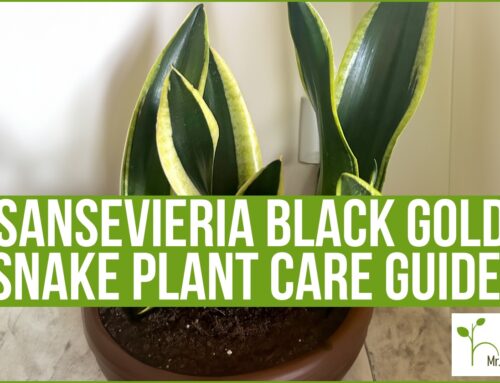

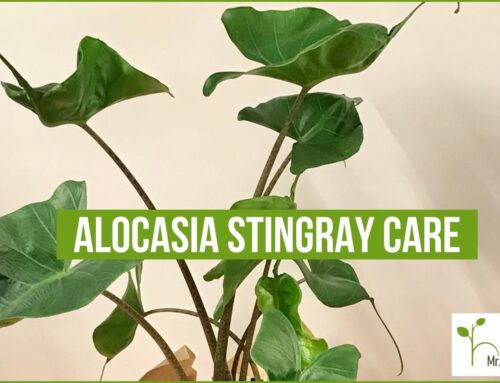

I was told to let my string of watermelons wrinkle slightly before watering. It is growing well and seems healthy, but this last time I watered when they started to wrinkle, they didn’t bounce back like they usually do and the leaves are still wrinkled/soft. Should I water more frequently? Thanks!
I assume you’re using a peat moss-based potting mix. Sometimes when it gets fully dry, it’s difficult to get it wet again, as peat moss is hydrophobic, it repels water. It’s possible even though you watered it, that the water just ran through the soil, and that only a small part of the soil actually absorbed water. You can try checking the soil an inch below the surface in several spots to see if the soil is wet. As I mentioned, often times the surface will be wet, but the soil below will still be dry.
In that case, you can try watering again, once or twice, sometimes even a few times, until the soil gets fully moist. But you also don’t want to saturate the soil too much, as you need it to dry out in about a week or so.
In the future you could also try bottom watering, as this is an easier way to get a peat-moss based mix wet. But it will also saturate the soil fully, so again, be careful. You still want to soil to dry out in about a week or so.
Waiting until they become wrinkly in order to water can be an ok technique. I would suggest once you know how long it takes for this to happen, water a day or two before it happens. You still should make sure the soil is fully dry before watering and for this you can use a chopstick.
The soil isn’t peat moss based, but is more sandy and contains a lot of perlite. I did try bottom watering for the first time recently and it took in a LOT of water! But it did drain well and wasn’t soggy. I will definitely try watering a bit sooner next time–I have been keeping track of how often it has been needing water since I got it. Thank you so much for your help!! I really appreciate it!
Do you have recommendations on how to prevent/kill white fluffy mold on the soil? My string of watermelons is thriving since I started bottom watering, but there is white mold around the drainage holes. The soil doesn’t seem to stay soaking wet and drains pretty well.
Generally the way to get rid of mold would be to increase airflow (add a fan), increase direct sun exposure (but you have to be careful to not do it for too long or when the sun is too strong) and reduce watering frequency or amount. You could also treat the soil and pot with hydrogen peroxide. I actually have a blog post on how to remove white mold from terracotta pots. I suggest checking it out, to make sure you have mold and not mineral deposits.